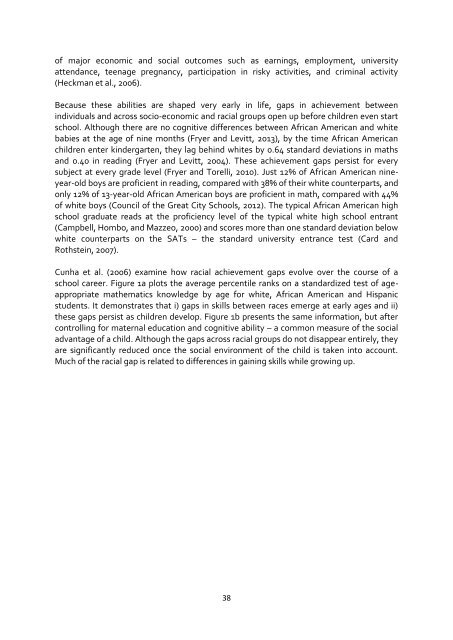UNCONSCIOUS BIAS AND EDUCATION
unconsious-bias-and-education
unconsious-bias-and-education
Create successful ePaper yourself
Turn your PDF publications into a flip-book with our unique Google optimized e-Paper software.
of major economic and social outcomes such as earnings, employment, university<br />
attendance, teenage pregnancy, participation in risky activities, and criminal activity<br />
(Heckman et al., 2006).<br />
Because these abilities are shaped very early in life, gaps in achievement between<br />
individuals and across socio-economic and racial groups open up before children even start<br />
school. Although there are no cognitive differences between African American and white<br />
babies at the age of nine months (Fryer and Levitt, 2013), by the time African American<br />
children enter kindergarten, they lag behind whites by 0.64 standard deviations in maths<br />
and 0.40 in reading (Fryer and Levitt, 2004). These achievement gaps persist for every<br />
subject at every grade level (Fryer and Torelli, 2010). Just 12% of African American nineyear-old<br />
boys are proficient in reading, compared with 38% of their white counterparts, and<br />
only 12% of 13-year-old African American boys are proficient in math, compared with 44%<br />
of white boys (Council of the Great City Schools, 2012). The typical African American high<br />
school graduate reads at the proficiency level of the typical white high school entrant<br />
(Campbell, Hombo, and Mazzeo, 2000) and scores more than one standard deviation below<br />
white counterparts on the SATs – the standard university entrance test (Card and<br />
Rothstein, 2007).<br />
Cunha et al. (2006) examine how racial achievement gaps evolve over the course of a<br />
school career. Figure 1a plots the average percentile ranks on a standardized test of ageappropriate<br />
mathematics knowledge by age for white, African American and Hispanic<br />
students. It demonstrates that i) gaps in skills between races emerge at early ages and ii)<br />
these gaps persist as children develop. Figure 1b presents the same information, but after<br />
controlling for maternal education and cognitive ability – a common measure of the social<br />
advantage of a child. Although the gaps across racial groups do not disappear entirely, they<br />
are significantly reduced once the social environment of the child is taken into account.<br />
Much of the racial gap is related to differences in gaining skills while growing up.<br />
38


